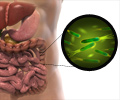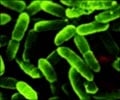Gene Swaps in the Gut: Common gut bacteria pacify their hostile neighbors by transferring genes that alter their defense mechanisms.

Advertisement
Gut Bacteria Swap Genes to Disarm Competitors
New research from the University of Chicago shows that a large, ubiquitous mobile genetic element changes the antagonistic weaponry of Bacteroides fragilis, a common bacterium of the human gut. Acquisition of this element shuts down a potent weapon of B. fragilis, yet arms it with a new weapon to which the strain that donated the DNA is protected. These weapons help the bacteria carve out niches in the tightly packed recesses of the gut.Laurie Comstock, Ph.D., Professor of Microbiology and member of the Duchossois Family Institute at UChicago, and senior author of the new study, has been studying different antagonistic mechanisms of Bacteroidales and the way they transfer DNA for more than 10 years. “These organisms evolve rapidly by DNA transfers. It’s quite amazing,” she said. “We knew that some strains of B. fragilis couldn’t fire their weapons, but when we saw it was due to the acquisition of a large mobile genetic element, that’s when we knew we found something interesting.”
The study, “A ubiquitous mobile genetic element changes the antagonistic weaponry of a human gut symbiont,” was published in Science (1✔ ✔Trusted Source
A ubiquitous mobile genetic element changes the antagonistic weaponry of a human gut symbiont
Go to source).
Advertisement
Gut Bacteria’s Secret Weapon: A Spring-Loaded, Poison-Tipped Spear
Many Bacteroidales species can kill neighboring bacteria by producing toxins. Some of these toxins simply diffuse from the bacterial cell into the surrounding environment, killing nearby sensitive strains. Another weapon is the type VI secretion system (T6SS), which is a nanomachine containing a pointed, spring-loaded tube loaded with toxins. When it fires, it injects toxins directly into neighboring cells like a poison-tipped spear.The Bacteroidales T6SS comes in three different types, or genetic architectures. One, genetic architecture 3 (GA3), is exclusive to B. fragilis and is very effective at killing other Bacteroidales species. The other two types, GA1 and GA2, are encoded by genes contained on large mobile genetic elements called integrative and conjugative elements (ICEs). These GA1 and GA2 ICEs are rapidly transferring between Bacteroidales species in the human gut throughout the world. However, scientists have yet to observe the same, lethal potency in GA1 and GA2 T6SSs as they have for the GA3 T6SS.
“The ICE containing the GA1 T6SS ICE is racing through human populations, and rapidly transferring to numerous Bacteroidales species in a person’s gut,” Comstock said.
Comstock’s team started studying natural B. fragilis isolates that had a GA3 T6SS or had both a GA3 and GA1 ICE. Those with both ICEs no longer fired the GA3 weapon and could no longer kill other Bacteriodales species. To show this was due to the addition of the GA1 ICE to these strains, they transferred the GA1 ICE into B. fragilis strains with only the GA3 T6SS and showed that the resulting new strains, or “transconjugants,” were similarly unable to antagonize other strains with their GA3 T6SS.
The researchers then deleted portions of the GA1 ICE to see which region of the 116 kilobase ICE was shutting off the GA3 weapon. They found that a portion of the GA1 T6SS region encoding the membrane complex of the GA1 nanomachine prevented GA3 T6SS firing.
Next, the team wanted to see how the strains would compete in the mammalian gut. They orally inoculated gnotobiotic (germ-free) mice with equal numbers of isogenic, wild-type B. fragilis (GA3 T6SS only) and the GA3/GA1 ICE transconjugant. The transconjugant quickly outcompeted the wild-type strain in the mice. The investigators went on to show that that this competition was due to antagonism using the GA1 T6SS, the first demonstration of potent antagonism by the GA1 T6SS.
“We didn’t know if the GA1 containing strain was going to be antagonistic, so we thought the progenitor GA3 strain would win that battle in the gut,” Comstock said. “But that was not what happened.”
Advertisement
Microbial Warfare: Switching Sides and Going on Defense
The most unexpected finding from this experiment was that in the mouse gut, the GA3 T6SS was not being made at all. They later showed that a gene carried on the GA1 ICE encodes a transcriptional repressor that shuts down transcription of the entire GA3 T6SS, allowing even better production of the GA1 T6SS.The overall effect of the transfer of this DNA element has consequences for the gut microbial community. The Bacteroidales strains containing the GA1 ICE are killed by the B. fragilis GA3 T6SS, but if one of these strains can transfer their GA1 ICE into the attacking B. fragilis strain, they create a strain that outcompetes the progenitor B. fragilis strain. This new strain no longer targets the donor strain and can also use the GA1 T6SS to communally defend the ecosystem from invasion by other Bacteroidales strains.
Comstock plans to continue studying this diverse family of transcriptional repressors that are frequently carried on mobile genetic elements of the Bacteroidales and their effects in recipient strains.
“This family of transcriptional repressors can be inactivated when they bind specific ligands. We would love to identify the ligands in the gut that derepress their activity,” she said.
The study also showed that in the mouse gut, the GA1 ICE transfer occurred rapidly, helping the transconjugant become a large component of the of the population. This suggests that researchers creating synthetic consortia of bacteria for therapeutics need to account for the effects of genetic transfer.
“As bacteria are being selected for inclusion in consortia as biotherapeutics, it is important to safeguard against introducing anything that could be transferred into or out of these strains that might have deleterious effects,” Comstock said.
References:
- A ubiquitous mobile genetic element changes the antagonistic weaponry of a human gut symbiont - (https://www.science.org/doi/10.1126/science.adj9504)
Source-Eurekalert















